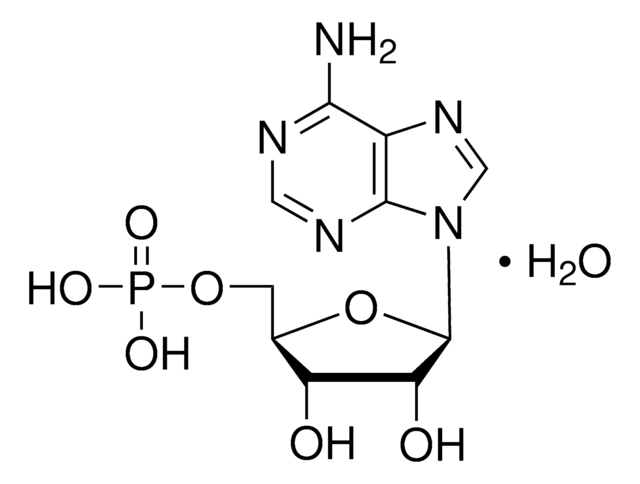추천 제품
Grade
for molecular biology
Quality Level
분석
≥99.0%
형태
powder
기술
affinity binding assay: suitable
protein purification: suitable
불순물
≤0.005% Insolubles
pH
5.0-6 (25 °C, 132 g/L)
solubility
H2O: 0.667 g/mL
음이온 미량물
chloride (Cl-): ≤5 ppm
양이온 미량물
Cu: ≤5 ppm
Fe: ≤5 ppm
Zn: ≤5 ppm
heavy metals (as Pb): ≤2 ppm
흡수
≤0.025 at 280 at 1 M
≤0.03 at 260 at 1 M
적합성
suitable for flow cytometry
suitable for molecular biology
응용 분야
metabolomics
microbiology
외래 활성
DNase, RNase, and protease, none detected
SMILES string
N.N.OS(O)(=O)=O
InChI
1S/2H3N.H2O4S/c;;1-5(2,3)4/h2*1H3;(H2,1,2,3,4)
InChI key
BFNBIHQBYMNNAN-UHFFFAOYSA-N
유사한 제품을 찾으십니까? 방문 제품 비교 안내
일반 설명
애플리케이션
- in the preparation of ′Blue Silver′ colloidal Coomassie stain for proteins.
- to precipitate the Shiga-like toxin from the culture supernatant.
- for precipitaion of viral particles from the culture supernatant.
특징 및 장점
- Heavy metals (as Pb): ≤2 ppm
- Free from DNase, RNase, and protease
기타 정보
Storage Class Code
11 - Combustible Solids
WGK
WGK 1
Flash Point (°F)
Not applicable
Flash Point (°C)
Not applicable
개인 보호 장비
Eyeshields, Gloves, type N95 (US)
시험 성적서(COA)
제품의 로트/배치 번호를 입력하여 시험 성적서(COA)을 검색하십시오. 로트 및 배치 번호는 제품 라벨에 있는 ‘로트’ 또는 ‘배치’라는 용어 뒤에서 찾을 수 있습니다.
이미 열람한 고객
자사의 과학자팀은 생명 과학, 재료 과학, 화학 합성, 크로마토그래피, 분석 및 기타 많은 영역을 포함한 모든 과학 분야에 경험이 있습니다..
고객지원팀으로 연락바랍니다.




